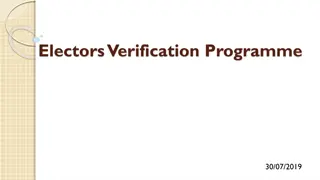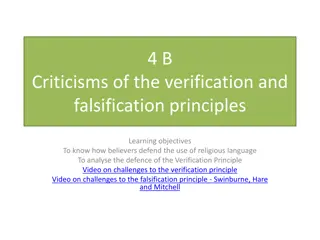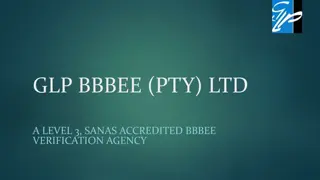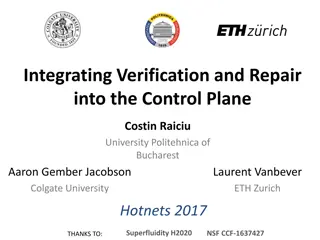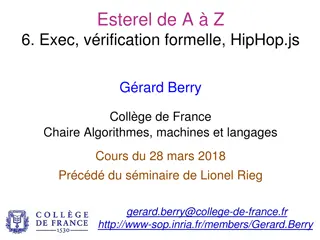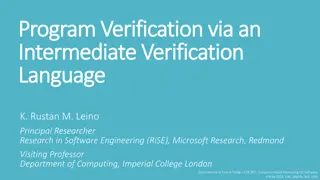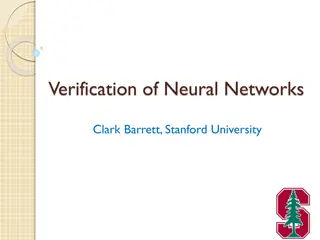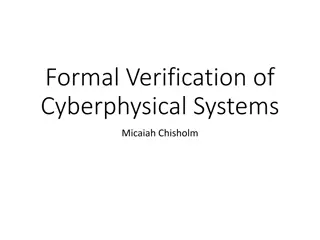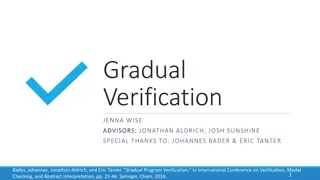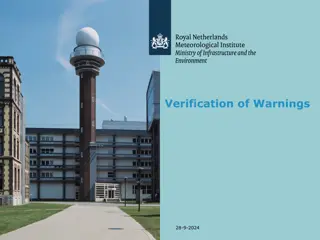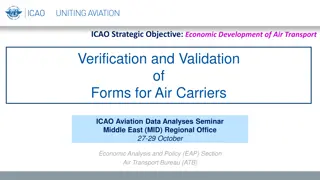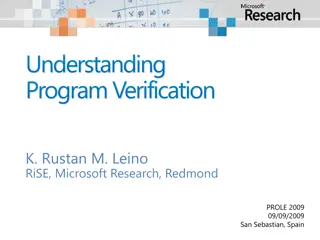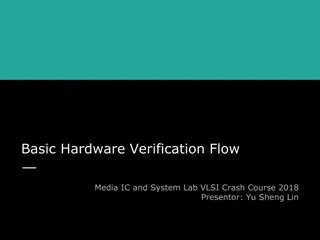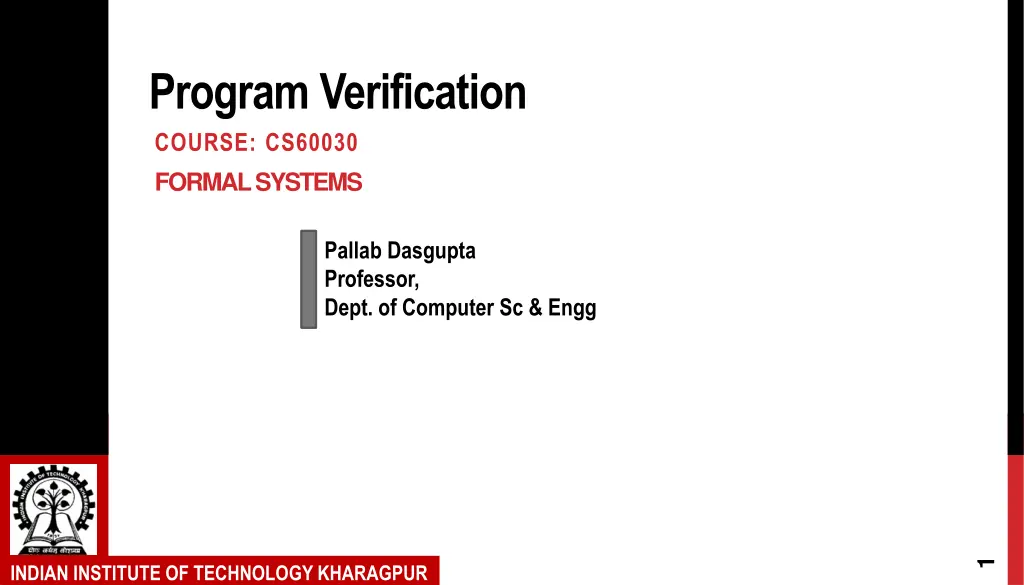
Software Verification Techniques and Abstraction Interpretation
Explore the realm of software verification, covering concepts such as formal systems, bug-free programming, abstraction soundness vs completeness, abstract static analysis, and control flow graphs. Dive into techniques like numerical abstract domains, model checking, and predicate abstraction to enhance software reliability and quality.
Download Presentation

Please find below an Image/Link to download the presentation.
The content on the website is provided AS IS for your information and personal use only. It may not be sold, licensed, or shared on other websites without obtaining consent from the author. If you encounter any issues during the download, it is possible that the publisher has removed the file from their server.
You are allowed to download the files provided on this website for personal or commercial use, subject to the condition that they are used lawfully. All files are the property of their respective owners.
The content on the website is provided AS IS for your information and personal use only. It may not be sold, licensed, or shared on other websites without obtaining consent from the author.
E N D
Presentation Transcript
Program Verification COURSE: CS60030 FORMAL SYSTEMS Pallab Dasgupta Professor, Dept. of Computer Sc & Engg 1 INDIAN INSTITUTE OF TECHNOLOGY KHARAGPUR
Software Verification Is a software program free from bugs? What kind of bugs? Lint checking Divide by zero, Variable values going out of range User specified bugs Assertions Challenges: Real valued variables Huge state space if we have to consider all values Size of the program is much smaller than the number of paths to be explored Branchings, Loops We need to extract an abstract state machine from a program 2
Abstraction: Sound versus Complete Sound Abstraction If the abstraction shows no bugs, then the original program also doesn t have bugs Complete Abstraction If the abstraction shows a bug, then the original program has a bug Due to undecidability of static analysis problems, we cant have a general procedure that is both sound and complete. 3
Techniques Abstract Static Analysis Abstract interpretation Numerical abstract domains Software Model Checking Explicit and symbolic model checking Predicate abstraction and abstraction refinement 4
Example Control Flow Graph (CFG): Sample program: int i=0 do { } L1 i=0; L2 Error [i>10] [i 10] assert( i <= 10); i = i+2; while (i < 5); [i<5] L3 i=i+2; L4 [i 5] L5 5
Sample program: int i=0 do { } Concrete Interpretation Philosophy: Collect the set of possible values of i until a fixed point is reached assert( i <= 10); i = i+2; while (i < 5); Int Int Int L1 L1 L1 i=0; i=0; i=0; {0,2,4} L2 {0,2} L2 {0} L2 Error Error Error [i>10] [i 10] {0,2,4} [i>10] [i 10] {0,2} [i>10] [i 10] {0} [i<5] L3 [i<5] L3 [i<5] L3 i=i+2; i=i+2; i=i+2; {2,4,6} {2,4} {2} L4 L4 L4 [i 5] {6} [i 5] [i 5] L5 L5 L5 Iteration-3 Iteration-2 Iteration-1 6
Sample program: int i=0 do { } Abstract Interpretation Philosophy: Use an abstract domain instead of value sets Example: We may use value intervals instead of value sets assert( i <= 10); i = i+2; while (i < 5); Iteration-1 Iteration-3 Iteration-2 [min, max] [min, max] [min, max] L1 L1 L1 i=0; i=0; i=0; [0,4] L2 [0,2] L2 [0,0] L2 Error Error Error [i>10] [i 10] [0,4] [i>10] [i 10] [0,2] [i>10] [i 10] [0,0] [i<5] L3 [i<5] L3 [i<5] L3 i=i+2; i=i+2; i=i+2; [2,6] [2,4] [2,2] L4 L4 L4 [i 5] [5,6] [i 5] [ ] [i 5] [ ] L5 L5 L5 Actually, the value 5 is not possible here 7
Numerical Abstract Domains The class of invariants that can be computed, and hence the properties that can be proved, varies with the expressive power of a domain An abstract domain can be more precise than another The information loss between different domains may be incomparable Examples: The domain of Signs has three values: {Pos, Neg, Zero} Intervals are more expressive than signs. Signs can be modeled as [min,0], [0,0], and [0,max] The domain of Parities abstracts values as Even and Odd Signs or Intervals cannot be compared with Parities. 8
Model Checking with Predicate Abstraction Aheavy-weight formal analysis technique Recent successes in software verification, e.g., SLAM at Microsoft The abstraction reduces the size of the model by removing irrelevant details The abstract model is then small enough for an analysis with a BDD-based Model Checker Idea: only track predicates on data, and remove data variables from model Mostly works with control-flowdominated properties Source of these slides: D. Kroening: SSFT12 Predicate Abstraction: A Tutorial 9
Outline Introduction Existential Abstraction Predicate Abstraction for Software Counterexample Guided Abstraction Refinement Computing Existential Abstractions of Programs Checking the Abstract Model Simulating the Counterexample Refining the Abstraction 1 0
Predicate Abstraction as Abstract Domain We are given a set of predicates over S, denoted by 1,..., n. An abstract state is a valuation of the predicates: S = Bn The abstraction function: (s) = ( 1(s), . . . , n(s)) 11
Predicate Abstraction: the Basic Idea Concrete states over variables x, y: x = 2 y = 1 x = 0 y = 0 x = 2 y = 0 x = 1 y = 0 x = 1 y = 1 x = 1 y = 2 Predicates: p1 x > y p2 y = 0
Predicate Abstraction: The Basic Idea Concrete states over variables x, y: x = 2 y = 0 x = 2 y = 1 p1, p2 x = 0 y = 0 p1,p2 p1,p2 x = 1 y = 0 x = 1 y = 1 x = 1 y = 2 p1, p2 Predicates: p1 p2 x > y y = 0 Abstract Transitions? 6
Existential Abstraction1 Definition (Existential Abstraction) A model M = (S ,S 0,T ) is an existential abstraction of M = (S,S0,T) with respect to : S S iff s S0. (s) = s s S 0 and (s, st) T. (s) = s (st) = s t (s , s t) T . 1Clarke, Grumberg, Long: Model Checking and Abstraction, ACM TOPLAS, 1994 7
Minimal Existential Abstractions There are obviously many choices for an existential abstraction for a given . Definition (Minimal Existential Abstraction) A model M = (S ,S 0,T ) is the minimal existential abstraction of M = (S,S0,T) with respect to : S S iff s S0. (s) = s (s, st) T. (s) = s (st) = s t s S 0 and (s , s t) T . This is the most precise existential abstraction. 8
Existential Abstraction We write ( ) for the abstraction of a path = s0,s1,...: ( ) = (s0), (s1),... 9
Existential Abstraction We write ( ) for the abstraction of a path = s0,s1,...: ( ) = (s0), (s1),... Lemma Let M be an existential abstraction of M . The abstraction of every path (trace) in M is a path (trace) in M . ( ) M M Proof by induction. We say that M overapproximates M . 9
Abstracting Properties Reminder: we are using a set of atomic propositions (predicates) A, and a state-labelling function L : S P (A) in order to define the meaning of propositions in our properties. 10
Abstracting Properties We define an abstract version of it as follows: First of all, the negationsare pushed into the atomic propositions. E.g., we will have x = 0 A and x 0 A 11
Abstracting Properties An abstract state s is labelled with a A iff all of the corresponding concrete states are labelled with a. a L (s ) s | (s) = s . a L(s) This also means that an abstract state may have neither the label x = 0 nor the label x 0 this may happen if it concretizes to concrete states with different labels! 12
Conservative Abstraction The keystone is that existential abstraction is conservative for certain properties: Theorem (Clarke/Grumberg/Long 1994) Let be a CTL* formula where all negations are pushed into the atomic propositions, and let M be an existential abstraction of M . If holds on M , then it also holds on M . M | = M | = We say that an existential abstraction is conservative for CTL* properties. The same result can be obtained for L TLproperties. The proof uses the lemma and is by induction on the structure of . The converse usually does not hold. 13
Back to the Example x = 2 y = 0 x = 2 y = 1 p1, p2 x = 0 y = 0 p1,p2 p1,p2 x = 1 y = 0 x = 1 y = 1 x = 1 y = 2 p1, p2 15
Lets try a Property x = 2 y = 0 x = 2 y = 1 p1, p2 x = 0 y = 0 p1,p2 p1,p2 x = 1 y = 0 x = 1 y = 1 x = 1 y = 2 p1, p2 Property: x > y y 0 p1 p2
Lets try a Property x = 0 y = 0 x = 2 y = 0 x = 2 y = 1 p1, p2 p1,p2 p1,p2 x = 1 y = 0 x = 1 y = 1 x = 1 y = 2 p1, p2 Property: x > y y 0 p1 p2 16
Another Property x = 0 y = 0 p1,p2 x = 2 y = 0 p1, p2 x = 1 y = 1 x = 2 y = 0 p1,p2 x = 1 y = 0 x = 1 y = 2 p1, p2 Property: x > y p1
Another Property x = 0 y = 0 p1,p2 x = 2 y = 0 p1, p2 x = 1 y = 1 x = 2 y = 0 p1,p2 x = 1 y = 0 x = 1 y = 2 p1, p2 Property: x > y p1
Another Property x = 2 y = 0 p1,p2 x = 0 y = 0 x = 2 y = 0 p1, p2 p1,p2 x = 1 y = 1 x = 1 y = 0 x = 1 y = 2 p1, p2 Property: x > y p1 17
Another Property x = 0 y = 0 x = 2 y = 0 x = 2 y = 0 p1,p2 p1, p2 p1,p2 x = 1 y = 1 x = 1 y = 2 x = 1 y = 0 p1, p2 Property: x > y p1 But: the counterexample is spurious 17
SLAM Microsoft blames most Windowscrashes on third party device drivers The Windowsdevice driver API is quite complicated Drivers are low level C code SLAM: T ool to automatically check device drivers for certain errors SLAM is shipped with Device Driver Development Kit Full detail available at http://research.microsoft.com/slam/ 18
SLIC Finite state language for defining properties o Monitors behavior of C code o T emporal safety properties (security automata) o familiar C syntax Suitable for expressing control-dominated properties o e.g., proper sequence of events o can track data values 19
SLIC Example state { enum { Locked , Unlocked} s = Unlocked ; } KeAcquireSpinLock . e n t r y { i f ( s==Locked ) abort ; e l s e s = Locked ; } acq unlocked locked rel KeReleaseSpinLock . entry { i f ( s==Unlocked ) abort ; e l s e s = Unlocked ; }
SLIC Example state { enum { Locked , Unlocked} s = Unlocked ; } KeAcquireSpinLock . e n t r y { i f ( s==Locked ) abort ; e l s e s = Locked ; } acq unlocked locked rel acq rel error KeReleaseSpinLock . entry { i f ( s==Unlocked ) abort ; e l s e s = Unlocked ; } 20
Refinement Example do { KeAcquireSpinLock(); nPacketsOld = nPackets; if(request) { request = request > Next; KeReleaseSpinLock(); nPackets++; } } while(nPackets != nPacketsOld); KeReleaseSpinLock (); 21
Refinement Example do { KeAcquireSpinLock(); nPacketsOld = nPackets; if(request) { request = request > Next; KeReleaseSpinLock(); Does this code obey the locking rule? nPackets++; } } while(nPackets != nPacketsOld); KeReleaseSpinLock (); 21
Refinement Example do { KeAcquireSpinLock(); if ( ) { KeReleaseSpinLock(); } } while( ); KeReleaseSpinLock (); 22
Refinement Example U do { L L KeAcquireSpinLock(); if ( ) { L KeReleaseSpinLock (); } U } while( ); L U KeReleaseSpinLock (); L U U E 22
Refinement Example U do { L L KeAcquireSpinLock(); if ( ) { L U KeReleaseSpinLock (); } L U } while( ); L U U KeReleaseSpinLock (); E 22
Refinement Example U do { L L KeAcquireSpinLock(); if ( ) { L U KeReleaseSpinLock (); } } while( ); L U L U U KeReleaseSpinLock (); Is this path concretizable? E 22
Refinement Example do { U L L KeAcquireSpinLock(); nPacketsOld = nPackets; if(request) { request = request > Next; KeReleaseSpinLock(); L U nPackets++; L U } } while(nPackets != nPacketsOld); L U U KeReleaseSpinLock (); E 23
Refinement Example do { U KeAcquireSpinLock(); L L nPacketsOld = nPackets; if(request) { request = request > Next; KeReleaseSpinLock(); L U nPackets++; } L U } while(nPackets != nPacketsOld); L U U KeReleaseSpinLock (); E This path is spurious! 23
Refinement Example do { U KeAcquireSpinLock(); L L nPacketsOld = nPackets; if(request) { request = request > Next; KeReleaseSpinLock(); L U nPackets++; } L U } while(nPackets != nPacketsOld); KeReleaseSpinLock (); L U U Let s add the predicate nPacketsOld==nPackets E 23
Refinement Example do { U KeAcquireSpinLock(); L L nPacketsOld = nPackets; if (request) { request = request >Next; KeReleaseSpinLock(); b=true; L U nPackets++; } L U } while(nPackets != nPacketsOld); L U U KeReleaseSpinLock (); E Let s add the predicate nPacketsOld==nPackets 23
Refinement Example do { U KeAcquireSpinLock(); L L nPacketsOld = nPackets; if (request) { request = request >Next; KeReleaseSpinLock(); b=true; L U b=b?false: ; nPackets++; } L U } while(nPackets != nPacketsOld); !b L U U KeReleaseSpinLock (); E Let s add the predicate nPacketsOld==nPackets 23
Refinement Example do { U KeAcquireSpinLock(); b=true; L L if ( ) { KeReleaseSpinLock (); L U b=b?false: ; } L U } while( ); !b L U U E KeReleaseSpinLock (); 24
Refinement Example do { U KeAcquireSpinLock(); b=true; L L b if ( ) { KeReleaseSpinLock (); L U b=b?false: ; } L U } while( ); !b L U U E KeReleaseSpinLock (); 24
Refinement Example do { U KeAcquireSpinLock(); b=true; L L b if ( ) { KeReleaseSpinLock (); L U b=b?false: ; } L U b } while( ); !b L U b b U E KeReleaseSpinLock (); 24
Refinement Example do { U KeAcquireSpinLock(); b=true; L L b if ( ) { KeReleaseSpinLock (); L b b U b=b?false: ; } L U b !b } while( ); !b L U b b U E KeReleaseSpinLock (); 24
Refinement Example do { U KeAcquireSpinLock(); b=true; L L b if ( ) { KeReleaseSpinLock (); L b b U b=b?false: ; } L U b !b } while( ); !b L U U E b b KeReleaseSpinLock (); 24
Refinement Example do { U KeAcquireSpinLock(); b=true; L L b if ( ) { KeReleaseSpinLock (); L b b U b=b?false: ; } L U b !b } while( ); !b L U U E b b KeReleaseSpinLock (); The property holds! 24


